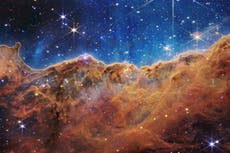The Independent's journalism is supported by our readers. When you purchase through links on our site, we may earn commission.
Scientists find the secret to birth of earliest black holes in the Cosmos
A 20-year puzzle about how the earliest monsters were born in the universe may have just been solved
It takes a long time to grow a supermassive black hole, even if it eats voraciously. So just how supermassive black holes billions of times heavier than the Sun formed within the first billion years of the universe has been an enduring puzzle.
But new work by an international team of cosmologists suggests an answer: flows of cold matter, shaped by mysterious dark matter, force-feeding black holes born from the deaths of gigantic primordial stars.
“There is a recipe for creating a 100,000 solar mass black hole at birth, and that is a 100,000 solar mass primordial star,” Daniel Whalen, a cosmologist at the University of Portsmouth, told The Independent. “In the universe today, the only black holes we’ve discovered, all formed from the collapse of massive stars. So that means the minimum mass for a black hole likely has to be at least three to four solar masses.”
But the gulf is huge between a 4 solar mass star and a 100,000 solar mass star, a “hypergiant” star that, if centered on the Sun, would extend out to the orbit of Pluto. For the past 20 years, Dr Whalen said, much of the research on early universe quasars – very bright centres of galaxies powered by supermassive black holes – has focused on the finely tuned set of conditions that would allow such a massive primordial star to form.
But in a new paper published in the journal Nature, Dr Whalen and his colleagues use supercomputer modeling of cosmic evolution to show that rather than developing from a set of very special circumstances, hyper-giant primordial stars form and collapse into the “seeds” of quasars quite naturally from a set of initial conditions that, while still relatively rare, are far less delicate. And it all starts with dark matter.
“If you look at the total content, let’s call it the total mass energy content of the universe, 3 per cent of it is in the form of matter we understand,” Dr Whalen said – matter made of protons and neutrons and electrons, hydrogen, helium and so forth. But “24 per cent is in the form of dark matter, and we know it’s there because of the motion of galaxies and clusters of galaxies, but we don’t know what it is.”
That is, dark matter only appears to interact with normal matter through gravity, and the gravity of dark matter is what created the largest scale structure of the universe: the cosmic web. Early in the universe, vast expanses of dark matter collapsed into long filaments under its own weight, Dr Whalen said, and dragged normal matter with it, forming a web of filaments and their intersections
Galaxies and stars would eventually form within the filaments and, particularly, the matter-rich intersections of the filaments.
“We call them halos, cosmological halos,” Dr Whalen said of the intersections, “and we think primordial stars first formed there.”
Previous thinking held that to form a large enough primordial star to birth a supermassive black hole and create a quasar within the first billion years of the universe, a halo would need to grow to massive proportions under special conditions: no other stars too nearby, the formation of molecular hydrogen in order to keep the gas cool, and supersonic flows of gas keeping the halo turbulent. So long as the halo is cool and turbulent enough, it cannot cohere enough to ignite as a star, prolonging its growth phase until it’s finally born at a tremendous size.
And once a massive star ignites, lives its life, burns out, and collapses into a black hole, it must have access to large amounts of gas in order to grow supermassive, Dr Whalen said, “because the way the black hole grows is by swallowing up gas”.
But rather than requiring finely tuned conditions for forming a massive star and, eventually, a massive black hole, Dr Whalen and his colleagues’ simulation suggests that cold gas flowing into a halo from the dark matter defined filaments of the cosmic web could replace the multitude of necessary factors for primordial star formation in older models.
“If cold accretion flows are fueling the growth of these halos, they must be pounding those halos,” Dr Whalen said, “pounding them with so much gas so quickly, that turbulence might be preventing the gas from collapsing and forming a primordial star.”
When they simulated such a halo fed by cold accretion flows, the researchers saw two massive primordial stars form, one as massive as 31,000 suns, and the other as massive as 40,000 suns. The seeds of supermassive black holes.
“It was beautifully simple. The problem for 20 years was gone overnight,” Dr Whalen said. Anytime you have cold flows pumping gas into a halo in the cosmic web, “you’re gonna have so much turbulence, that you’ll get supermassive star formation and massive seed formation that produces a massive quasar seed.”
It’s a finding that matches up with the number of quasars so far observed in the early universe, he added, noting that large halos at that early epoch are rare, and so are quasars.
But the new work is a simulation, and scientists would next like to actually observe the formation of an early-universe quasar in the wild. New instruments, such as the James Webb space telescope, may make that a reality relatively soon.
“Webb will be powerful to see one,” Dr Whalen said, perhaps viewing the birth of black holes within one or two million years of the Big Bang.
Join our commenting forum
Join thought-provoking conversations, follow other Independent readers and see their replies
Comments


Bookmark popover
Removed from bookmarks